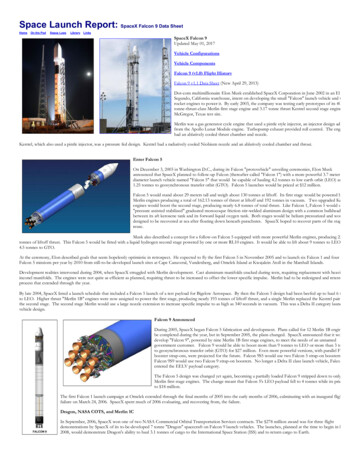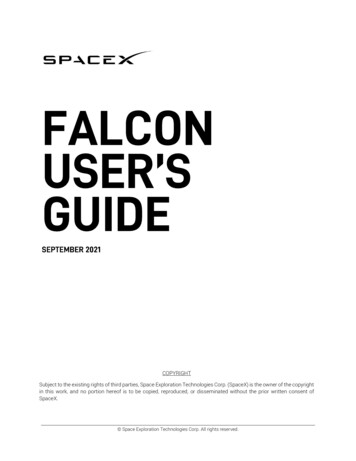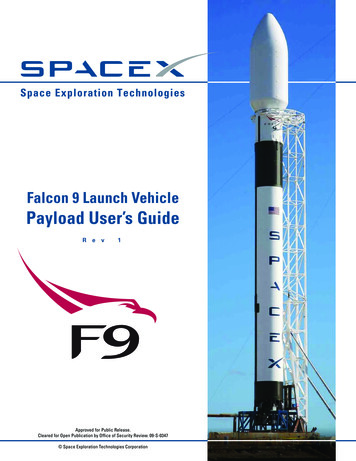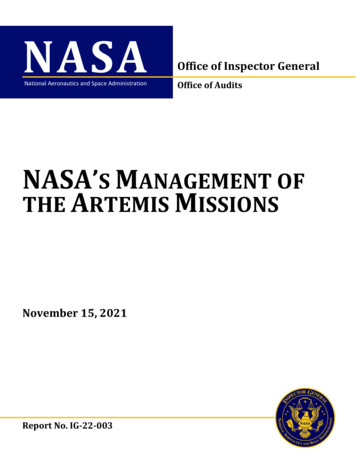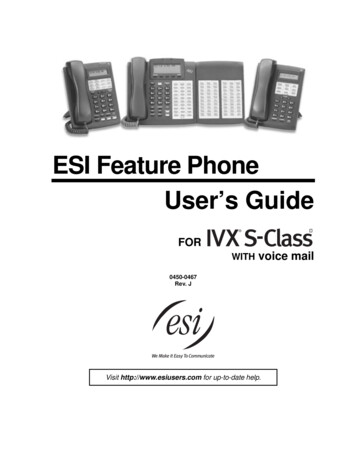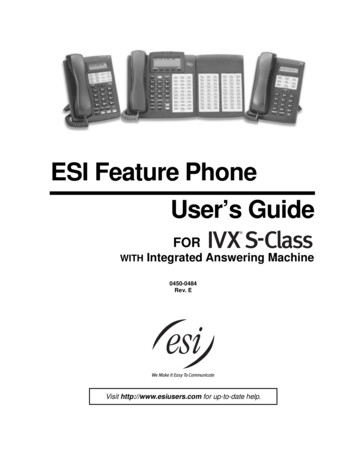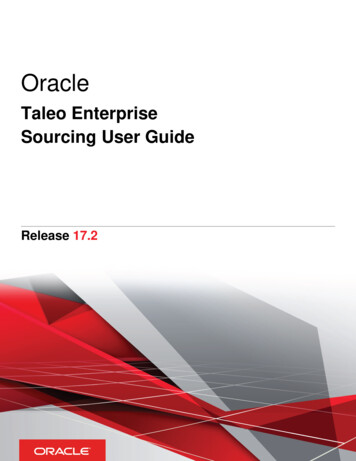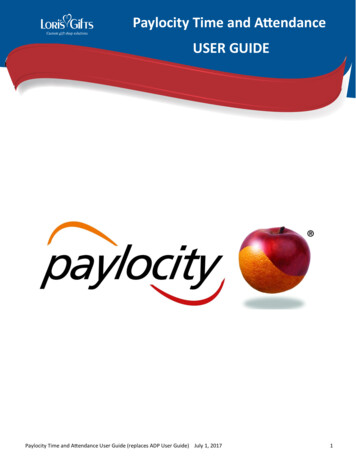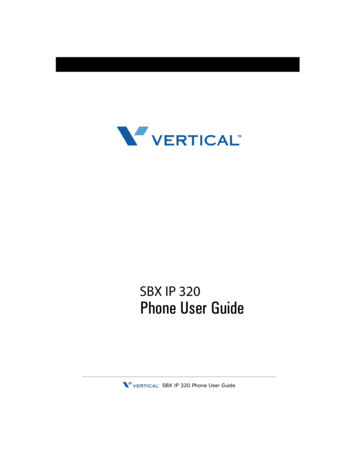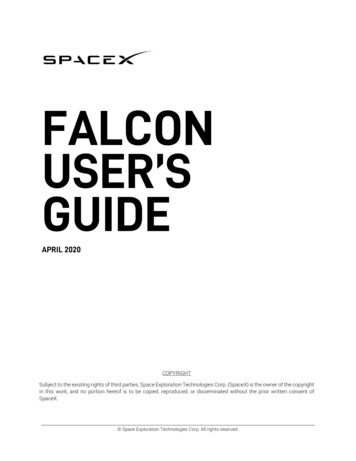
Transcription
FALCONUSER’SGUIDEAPRIL 2020COPYRIGHTSubject to the existing rights of third parties, Space Exploration Technologies Corp. (SpaceX) is the owner of the copyrightin this work, and no portion hereof is to be copied, reproduced, or disseminated without the prior written consent ofSpaceX. Space Exploration Technologies Corp. All rights reserved.
FALCON USER’S GUIDETABLE OF CONTENTS1INTRODUCTION .11.1User’s Guide Purpose . 11.2Company Description . 11.3Falcon Program Overview . 1Falcon Launch Vehicle Safety . 21.51.5.1Engines . 31.5.2Avionics. 41.5.3Staging Architecture and Design . 41.62Falcon Reliability . 3Pricing . 4VEHICLES . 5Falcon Vehicle Overview . 5Falcon Heavy Vehicle Overview . 5Structure and Propulsion. 6Retention, Release and Separation Systems . 8Avionics, and Guidance, Navigation and Control . 8Coordinate Frame . 83PERFORMANCE. 10Available Injection Orbits .10Mass-to-Orbit Capability .10Mass Properties . 11Launch Windows . 12Flight Attitude . 12Separation Attitude and Accuracy . 12Multiple Payloads . 13Secondary Payloads . 134ENVIRONMENTS. 14Transportation Environments. 14Temperature, Humidity and Cleanliness . 14Flight Environments . 154.3.1Loads .154.3.2Sine Vibration .174.3.3Acoustic .19 Space Exploration Technologies Corp. All rights reserved.ii
FALCON USER’S GUIDE4.3.4Shock .254.3.5Random Vibration .254.3.6Electromagnetic .284.3.7Fairing Internal Pressure .344.3.8Payload Temperature Exposure during Flight.344.3.9Free Molecular Heating .34Environmental Compatibility Verification . 355INTERFACES .36Mechanical Interfaces . 365.1.1Payload Adapters and Separation Systems .365.1.2Payload Fairing .36Electrical Interfaces . 385.2.1Connectivity during Payload Processing and on Launch Pad .385.2.2Falcon-to-Payload Command Interface .405.2.3Timing Services .40Interface Compatibility Verification Requirements .406FACILITIES. 41SpaceX East Coast Launch Facilities. 416.1.1Cape Canaveral Air Force Station, Florida .416.1.2Kennedy Space Center, Florida .416.1.3CCAFS & KSC Personnel Accommodations .42Vandenberg Air Force Base, California . 446.2.1VAFB Personnel Accommodations .45Headquarters—Hawthorne, CA . 47Rocket Development Facility—McGregor, TX. 47Government Outreach and Legal Affairs—Washington, DC . 477MISSION INTEGRATION AND SERVICES . 48Contracting . 48Mission Management . 48Standard Services . 49Schedule .50Customer Deliverables .508OPERATIONS .52Overview and Schedule . 52Spacecraft Delivery and Transportation . 52 Space Exploration Technologies Corp. All rights reserved.iii
FALCON USER’S GUIDESpacecraft Processing . 53Joint Operations and Integration . 55Launch Operations. 578.5.1Organization .578.5.2Spacecraft Control Center.578.5.3Launch Control .588.5.4Rollout, Erection and Pad Operations .588.5.5Countdown .598.5.6Recycle and Scrub .59Flight Operations . 598.6.1Liftoff and Ascent .598.6.2Spacecraft Separation .598.6.3Contamination and Collision Avoidance .598.6.4Post Launch Reports.598.6.5Disposal .59Sample Mission Profile .609SAFETY .63Safety Requirements . 63Hazardous Systems and Operations . 63Waivers. 6310 CONTACT INFORMATION . 6411 QUICK REFERENCE .65List of Figures . 65List of Tables. 66List of Acronyms . 66Change Log . 68 Space Exploration Technologies Corp. All rights reserved.iv
FALCON USER’S GUIDE1 INTRODUCTION1.1USER’S GUIDE PURPOSEThe Falcon launch vehicle user’s guide is a planning document provided for customers of SpaceX (Space ExplorationTechnologies Corp.). This document is applicable to the Falcon vehicle configurations with a 5.2 m (17-ft) diameterfairing and the related launch service (Section 2).This user’s guide is intended for pre-contract mission planning and for understanding SpaceX’s standard services. Theuser’s guide is not intended for detailed design use. Data for detailed design purposes will be exchanged directly betweena SpaceX customer and a SpaceX mission manager.SpaceX reserves the right to update this user’s guide as required. Future revisions are assumed to always be in processas SpaceX gathers additional data and works to improve its launch vehicle design.1.2COMPANY DESCRIPTIONSpaceX offers a family of launch vehicles that improves launch reliability and increases access to space. The companywas founded on the philosophy that simplicity, reliability and cost effectiveness are closely connected. We approach allelements of launch services with a focus on simplicity to both increase reliability and lower cost. The SpaceX corporatestructure is flat and business processes are lean, resulting in fast decision-making and product delivery. SpaceXproducts are designed to require low-infrastructure facilities with little overhead, while vehicle design teams are colocated with production and quality assurance staff to tighten the critical feedback loop. The result is highly reliable andproducible launch vehicles with quality embedded throughout the process.Established in 2002 by Elon Musk, the founder of Tesla Motors, PayPal and the Zip2 Corporation, SpaceX has developedand flown the Falcon 1 light-lift launch vehicle, the Falcon 9 medium-lift launch vehicle, the Falcon Heavy heavy-lift launchvehicle, the most powerful operational rocket in the world by a factor of two, and Dragon, which is the first commerciallyproduced spacecraft to visit the International Space Station.SpaceX has built a launch manifest that includes a broad array of commercial, government and international customers.In 2008, NASA selected the SpaceX Falcon 9 launch vehicle and Dragon spacecraft for the International Space StationCargo Resupply Services contract. NASA has also awarded SpaceX contracts to develop the capability to transportastronauts to space as well as to launch scientific satellites. In addition, SpaceX services the National Securitycommunity and is on contract with the Air Force for multiple missions on the Falcon family of launch vehicles.SpaceX has state-of-the-art production, testing, launch and operations facilities. SpaceX design and manufacturingfacilities are conveniently located near the Los Angeles International Airport. This location allows the company toleverage Southern California’s rich aerospace talent pool. The company also operates cutting-edge propulsion andstructural test facilities in Central Texas, along with launch sites in Florida and California, and the world’s first commercialorbital launch site in development in South Texas.1.3FALCON PROGRAM OVERVIEWDrawing on a history of prior launch vehicle and engine programs, SpaceX privately developed the Falcon family of launchvehicles. Component developments include first- and second-stage engines, cryogenic tank structures, avionics,guidance and control software, and ground support equipment.With the Falcon 9 and Falcon Heavy launch vehicles, SpaceX is able to offer a full spectrum of medium- and heavy-liftlaunch capabilities to its customers (Figure 1-1). SpaceX operates Falcon launch facilities at Cape Canaveral Air ForceStation, Kennedy Space Center, and Vandenberg Air Force Base and can deliver payloads to a wide range of inclinationsand altitudes, from low Earth orbit to geosynchronous transfer orbit to escape trajectories for interplanetary missions.Future missions will also be flown from our commercial orbital launch site under development in South Texas. Space Exploration Technologies Corp. All rights reserved.1
FALCON USER’S GUIDEFigure 1-1: SpaceX vehicles are designed for high cross-platform commonalityThe Falcon family has conducted successful flights to the International Space Station (ISS), low Earth orbit (LEO), highlyelliptical orbit (HEO), geosynchronous transfer orbit (GTO), and Earth-escape trajectories. A partial flight manifest for theFalcon program can be found at www.spacex.com/missions.Reusability is an integral part of the Falcon program. SpaceX pioneered reusability with the first re-flight of an orbitalclass rocket in 2017. As of this writing, SpaceX has re-flown rockets more than fifteen times. In 2018, SpaceX had moremissions launching with a flight-proven rocket than a first flight rocket. By re-flying boosters, SpaceX increases reliabilityand improves its designs and procedures by servicing and inspecting hardware as well as incorporating lessons thatcan only be learned from flight.FALCON LAUNCH VEHICLE SAFETYThe Falcon launch vehicles were designed from the beginning to meet NASA human-rated safety margins. We continueto push the limits of rocket technology as we design the safest crew transportation system ever flown whilesimultaneously advancing toward fully reusable launch vehicles. Our emphasis on safety has led to advancements suchas increased structural factors of safety, greater redundancy, and rigorous fault mitigation. Because SpaceX producesone Falcon core vehicle, satellite customers benefit from the high design standards required to safely transport crew.The major safety features are listed in more detail in Table 1-1. Space Exploration Technologies Corp. All rights reserved.2
FALCON USER’S GUIDETable 1-1: Key safety features of Falcon launch vehiclesDesign/Operations FeatureSafety BenefitDesigned to NASA human-rating margins and safetyrequirementsImproves reliability for payloads without crew throughincreased factors of safety, redundancy and faultmitigationReduces work at height during numerousmanufacturing, processing and integration procedures,and eliminates many overhead operationsSignificantly improves safety by eliminating hazardousground handling operations required for systems thatuse solid propellant cores or boostersHorizontal manufacturing, processing and integrationAll-liquid propulsion architecture; fuel and oxidizer arestored separately on the ground and in the vehicle.Propellant is not loaded into the vehicle until the vehicleis erected for launchRocket-grade kerosene and liquid oxygen as primarypropellantsNon-explosive, pneumatic release and separationsystemsRegular hardware-in-the-loop (HITL) software testing1.5Reduces health hazards to processing, integration, andrecovery personnel compared to systems that use hightoxicity primary propellantsZero-debris separation systems significantly reduceorbital debris signature, can be repeatedly tested duringthe manufacturing process, and eliminate hazardouspyrotechnic devicesComplete verification of entire mission profile prior toflightFALCON RELIABILITYA study 1 by The Aerospace Corporation found that 91% of known launch vehicle failures in the previous two decadescan be attributed to three causes: engine, avionics, and stage separation failures. With this in mind, SpaceX incorporatedkey engine, avionics, and staging reliability features for high reliability at the architectural level of Falcon launch vehicles.Significant contributors to reliability include:1.5.1ENGINESThe Merlin engine that powers the Falcon family of launch vehicles is the only new hydrocarbon engine to be successfullydeveloped and flown in the U.S. in the past 40 years. It has the highest thrust-weight ratio of any boost engine ever made.The liquid-propelled Merlin powers the Falcon propulsion system. The engine features a reliable turbopump design witha single shaft for the liquid oxygen pump, the fuel pump, and the turbine. The engine uses a gas generator cycle insteadof the more complex staged combustion cycle. The regeneratively cooled nozzle and thrust chamber use a milled copperalloy liner that provides large heat flux margins. A pintle injector provides inherent combustion stability.Engine failure modes are minimized by eliminating separate subsystems where appropriate. For example, the first-stagethrust vector control system pulls from the high-pressure rocket-grade kerosene system, rather than using a separatehydraulic fluid and pressurization system. Using fuel as the hydraulic fluid eliminates potential failures associated witha separate hydraulic system and with the depletion of hydraulic fluid.The high-volume engine production required to fly 10 Merlin engines (Falcon 9) or 28 engines (Falcon Heavy) on everylaunch results in high product quality and repeatability through process control and continuous production. Flyingseveral engines on each mission also quickly builds substantial engineering data and flight heritage.During Falcon launch operations, the first stage is held on the ground after engine ignition while automated monitorsconfirm nominal engine operation. An autonomous safe shutdown is performed if any off-nominal condition is detected.1Chang, I-Shih. “Space Launch Vehicle Reliability,” Aerospace Corporation Publication (2001). Space Exploration Technologies Corp. All rights reserved.3
FALCON USER’S GUIDEHold-on-pad operations, enabled by the launch vehicle’s all-liquid propulsion architecture and autonomous countdownsequence, significantly reduce risks associated with engine start-up failures and underperformance.By employing multiple first-stage engines, SpaceX offers the world’s first evolved expendable launch vehicle (EELV)class system with engine-out capability through much of first-stage flight. System-level vehicle management softwarecontrols the shutdown of engines in response to off-nominal engine indications. Although the likelihood of catastrophicengine failure is low, and failing engines are designed to be shut down prior to a catastrophic failure, each engine ishoused within its own metal bay to isolate it from neighboring engines.The second-stage Merlin Vacuum engine uses a fixed, non-deploying expansion nozzle, eliminating potential failuremodes in nozzle extension.1.5.2AVIONICSFalcon launch vehicle avionics, and guidance, navigation and control systems use a fault-tolerant architecture thatprovides full vehicle single-fault tolerance and uses modern computing and networking technology to improveperformance and reliability. The fault tolerance is achieved either by isolating compartments within avionics boxes or byusing triplicated units of specific components. Both the first and second stages host their own multiple redundantlithium-ion batteries to minimize the complexity of the electrical interface.1.5.3STAGING ARCHITECTURE AND DESIGNThe two-stage Falcon 9 architecture was selected to minimize the number of stage separation events, eliminatingpotential failure modes associated with third- and fourth-stage separations, as well as potential engine deployment andignition failure modes in the third and fourth stages. Falcon Heavy uses the same stage architecture as Falcon 9 withthe addition of two separating side cores.The Falcon second-stage and Falcon Heavy side-boosters restraint, release, and separation systems use pneumaticdevices that provide low-shock release and positive force separation over a comparatively long stroke. The pneumaticsystem allows for acceptance and functional testing of the actual flight hardware, which is not possible with a traditionalexplosives-based separation system.For each Falcon launch vehicle, SpaceX performs an exhaustive series of tests from the component to the vehiclesystem level. The test program includes component-level flight acceptance and workmanship testing, structures loadand proof testing, flight system and propulsion subsystem-level testing, full first- and second-stage testing up to fullsystem testing (including first- and second-stage static fire testing), as well as a static fire test on the launch pad. Inaddition to testing environmental extremes (plus margin), flight critical and workmanship sensitive hardware are testedto account for off-nominal conditions. For example, stage separation tests are performed for off-nominal cases withrespect to geometrical misalignment, anomalous timing and sequencing.The Falcon first stage is designed to survive atmospheric entry and to be recovered, handling both the rigors of theascent portion of the mission and the loads of the recovery portion. Stage recoverability also provides a uniqueopportunity to examine recovered hardware and assess design and material selection in order to continually improveFalcon 9 and Falcon Heavy.1.6PRICINGThe standard price for Falcon 9 and Falcon Heavy launch services can be found at www.spacex.com/about/capabilities.Pricing includes range services, standard payload integration and third-party liability insurance. Please see Section 7.3for a complete
SpaceX has state-of-the-art production, testing, launch and operations facilities. SpaceX design and manufacturing facilities are conveniently located near the Los Angeles International Airport. This location allows the company to leverage Southern California's rich aerospace talent pool. The company also operates cutting-edge propulsion and
